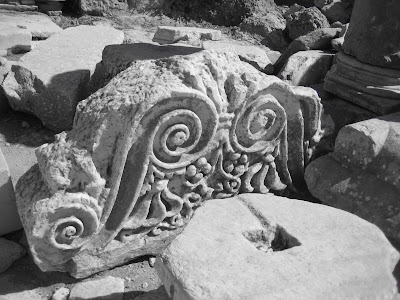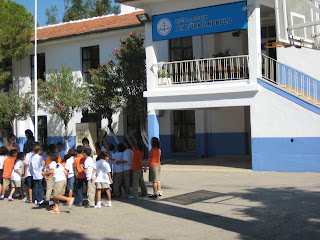My alarm went off at 6:00 am this morning…..the sky was
still dark, but I had to get up and ready myself for the daytrip to Ephesus. On my way to the
new mosque, I walked along the familiar path bordering the seafront to the left
and the beachfront restaurants, cafes and clubs on the right. I couldn’t quite determine in some cases
whether the handful of people I saw and heard in the predawn light were just
starting the day, or finally ending the previous one…..
At the mosque, I stood waiting for the shuttle bus that
would take me to the main tour bus. A
moment later, another individual arrived who also appeared to be waiting. He introduced himself as Faust, an Italian
from Sicily
with long dark hair, beard, dressed all in black, and bearing a large tattoo on
one forearm. Faust, I soon learned,
lives in Amsterdam
and works for booking.com handling customer complaints! I told him that I had booked my hotel here
through booking.com, but so far have no complaints…
Our shuttle arrived, and we rendezvoused with the tour bus
in Torba, picking up various other passengers from their hotels along the
route. Our tour guide, Ahmet, was
cheerful and joking with us in order to jolt us awake. Enroute to Ephesus, we made two stops – one
to eat a Turkish breakfast beside a lake, and the second, a typical Turkish
tourist trap trick, to shop at a large jewelry showroom. There we were “held captive” for 45 minutes,
looking at beautiful but expensive gold jewelry and precious gems.
The lake formed over a period of centuries during which
continuous deposits of silt in the Menderes
River basin gradually
filled in, creating an extremely fertile alluvial plain and this large inland
lake which is a mixture of sea water and fresh water. The local people live from fishing these
waters, and growing a variety of crops in the rich soil. Now in September, we saw fields filled with
cotton ready to be picked.(This reminded me of the cotton fields of Georgia that I first saw on a roadtrip to visit my aunt and
uncle in Florida
when I was 11 years old. I recall my
shock at seeing African Americans living in shacks as though the civil war had ended yesterday…)
Our guide told us that the same fields were used in a successful crop rotation
plan that produced cotton in summer, sunflowers in the autumn and rice in the
winter months when the fields are flooded.
We saw many olive groves, as Turkey is a big producer of olive
oil. The Anatolia region produces black, green
and red olives. I wondered why we rarely see Turkish olive oil for sale in Western
Europe, or in the U.S.market where all olive oil is almost exclusively from Italy. Faust mused that not much wine is produced in Turkey despite
conducive climatic conditions, but we concluded together that this is perhaps
due to the fact that Turkey is a Muslim country, secular or not!
Upon arrival at Ephesus,
we quickly surmised that off-season or not, this is a big attraction, second
only to Cappadoccia. Our guide explained that many buses bring groups from
cruise ships that dock all along the Aegean coast. Nevertheless, Ephesus, or Efes as the Turks call it, did
not disappoint. This was an ancient
Greek colony founded near a prehistoric site that has been dated back to 5,000
B.C. The Myceneans and Hittites also settled here. The Greek settlement fell
under Roman rule in 133 B.C. and reached its height under the reign of Emperor
Augustus. Ephesus
became the capital of the Asian province of the Roman
Empire, and was at its peak a city of 250,000, as much as half of
this population consisting of slaves. Recent excavations have focused on the
so-called “slope houses” located across from Hadrian’s Temple.
Archeologists have uncovered two city blocks of these luxurious
dwellings which were two-storied with frescoed walls and mosaic floors. They were heated by hot air circulated in the
walls in winter, and had both hot and cold running water. The basic plan was peristyle, meaning that
each house had an inner courtyard or atrium that provided light and access to
air since there were no outside windows.
It is believed that there are approximately 2,000 such houses still
under the ground.
We walked along the three main streets (Kurets, Marble and
Harbor Streets ) of this city which is being slowly uncovered by a team of
Austrian archeologists. They have been
working since the early 20th century, but have still only brought
approximately 30% of the total city to
light. Most amazing is the fact that
this city, the largest in the ancient world, was established as a port. The aforementioned silting in of the river
basin caused this city to become landlocked as the coast moved further and
further away over the centuries.
At Ephesus
we could see the huge amphitheatre, and the impressive Celsus Library from the
first quarter of the 2nd century A.D. Even in its ruined state, it is a majestic
structure that symbolizes Ephesus
with its classical beauty and proportions.
We also saw a frieze depicting Nike, or winged Victory as the Romans
called her, Our guide claimed that the rope we saw in front of Nike was placed
there to prevent visitors from touching the right breast of Nike which is said
to bring victory to those who do so! He
said that over many years, her right breast had grown smaller than the left so
it is now off-limits.
After the tour, we were driven to the nearby town of Selçuk which has an
impressive fortress high on a hill overlooking the city of 32,000. We had a buffet lunch there included in the
tour, and I indulged in a glass of pure, freshly squeezed pomegranate juice.
(see photo)



























































